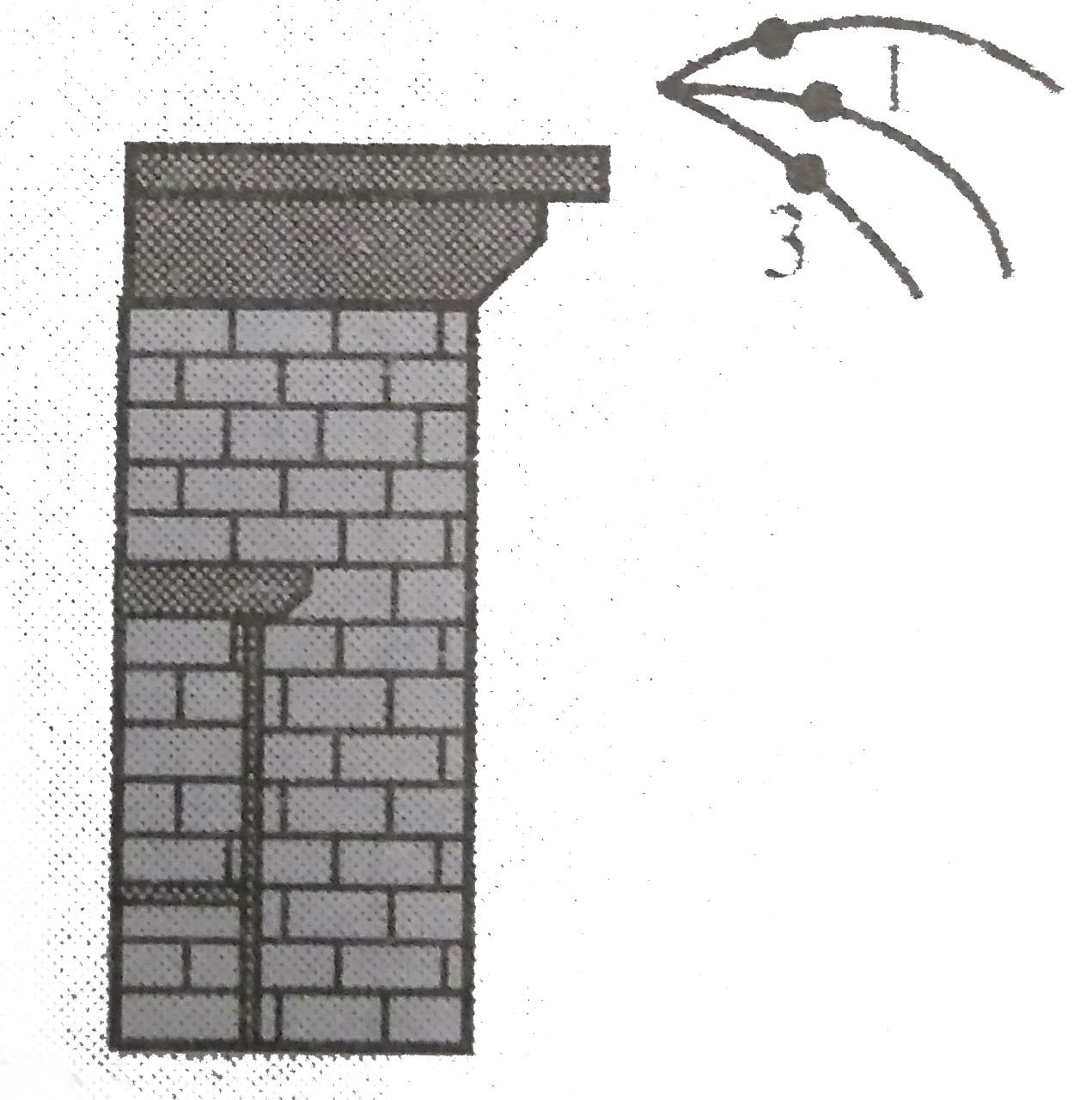Three particles A, B and C are thrown from the top of a tower with the same speed. A is thrown straight up, B is thrown straight down and C is thrown horizontally. They hit the ground with speeds vA,vB and vC respectively:
vA=vB>vC
vA=vB=vC
vA>vB=vC
vB>vC>vA
The correct Answer is:B
To solve the problem, we need to analyze the motion of the three particles A, B, and C, which are thrown from the top of a tower with the same initial speed U. We will derive the final speeds vA, vB, and vC for each particle when they hit the ground.
Step 1: Analyze Particle A (Thrown Upwards)
When particle A is thrown straight up, it will first move upwards, come to a stop at its maximum height, and then fall back down to the ground.
Using the equation of motion:
v2A=U2−2gH
At the maximum height, the final velocity vA will be zero. When it falls back down to the height H, we can express the final speed as:
v2A=U2+2gH(since it falls back down)
Step 2: Analyze Particle B (Thrown Downwards)
For particle B, which is thrown straight down, we can use the same equation of motion:
v2B=U2+2gH
Since it is thrown downwards, the initial speed adds to the speed gained from falling.
Step 3: Analyze Particle C (Thrown Horizontally)
For particle C, which is thrown horizontally, we need to consider both horizontal and vertical components of its motion.
1. Horizontal Component: The horizontal speed remains constant:
vCx=U
2. Vertical Component: The vertical motion is similar to free fall:
v2Cy=0+2gH=2gH
Thus, the vertical speed when it hits the ground is:
vCy=√2gH
Now, we can find the resultant speed vC using Pythagoras' theorem:
v2C=v2Cx+v2Cy=U2+(2gH)
Step 4: Compare the Speeds
Now we have:
- For particle A:
v2A=U2+2gH
- For particle B:
v2B=U2+2gH
- For particle C:
v2C=U2+2gH
From this, we can conclude that:
vA=vB=vC
Conclusion
All three particles hit the ground with the same speed:
vA=vB=vC
When particle A is thrown straight up, it will first move upwards, come to a stop at its maximum height, and then fall back down to the ground.
v2A=U2−2gH
At the maximum height, the final velocity vA will be zero. When it falls back down to the height H, we can express the final speed as:
v2A=U2+2gH(since it falls back down)
For particle B, which is thrown straight down, we can use the same equation of motion:
v2B=U2+2gH
Since it is thrown downwards, the initial speed adds to the speed gained from falling.
For particle C, which is thrown horizontally, we need to consider both horizontal and vertical components of its motion.
vCx=U
v2Cy=0+2gH=2gH
Thus, the vertical speed when it hits the ground is:
vCy=√2gH
v2C=v2Cx+v2Cy=U2+(2gH)
Now we have:
- For particle A:
v2A=U2+2gH
- For particle B:
v2B=U2+2gH
- For particle C:
v2C=U2+2gH
vA=vB=vC
All three particles hit the ground with the same speed:
vA=vB=vC
Topper's Solved these Questions
- WORK, ENERGY AND POWERBOOK - DC PANDEY ENGLISHCHAPTER - WORK, ENERGY AND POWEREXERCISE - MEDICAL ENTRANCE SPECIAL QUESTIONS
16 Videos
- WORK, ENERGY AND POWERBOOK - DC PANDEY ENGLISHCHAPTER - WORK, ENERGY AND POWEREXERCISE - MATCH THE COLUMNS
7 Videos
- WORK, ENERGY AND POWERBOOK - DC PANDEY ENGLISHCHAPTER - WORK, ENERGY AND POWEREXERCISE - CHECK POINT 6.3
10 Videos
- WORK, ENERGY & POWERBOOK - DC PANDEY ENGLISHCHAPTER - WORK, ENERGY & POWEREXERCISE - Level 2 Comprehension Based
2 Videos
- WORK, POWER AND ENERGYBOOK - DC PANDEY ENGLISHCHAPTER - WORK, POWER AND ENERGYEXERCISE - E Integer Type Questions
11 Videos
Similar Questions
Thre stones A, B and C are simultaneously projected from same point with same speed. A is thrown upwards, B is thrown horizontally and C is thrown downwards from a boulding. When the distance between stone A and C becomes 10 m, then distance between A and B will be-
View SolutionFor body thrown horizontally from the top of a tower,
View SolutionThree identical balls are thrown from the top of a building, all with the same initial speed. As shown in figure., the first ball is thrown horizontally, second above horizontal level, and third at an angle below the horizontal. Neglecting air resistance, rank the speeds of the balls at the instant each hits the ground.

View SolutionA ball is thrown straight up. What is its velocity and acceleration at the top?
View SolutionA ball of mass m is thrown straight up. It goes to a maximum height and then returns. Finally it strikes ground. In the whole process.
View SolutionA person standing near the edge of the top of a building throws two balls A and B. The ball A is thrown vertically upward and B is thrown vertically downward with the same speed. The ball A hits the ground with speed vA and the ball B hits the ground wiht a speed vB. We have
View SolutionA heavy stone is thrown from a cliff of height h with a speed v. The stone will hit the ground with maximum speed if it is thrown
View SolutionTwo balls AandB of same masses are thrown from the top of the building A. Thrown upward with velocity VandB, thrown downward with velocity V, then
View SolutionTwo projectiles A and B are thrown from the same point with velocities v and v2 respectively. If B is thrown at an angle 45∘ with horizontal.What is the inclination of A.when their ranges are the same?
View SolutionA body is thrown horizontally from the top of a tower and strikes the ground after three seconds at an angle of 45∘ ,with the horizontal . Then find ,
(i) The height of the tower
View Solution
